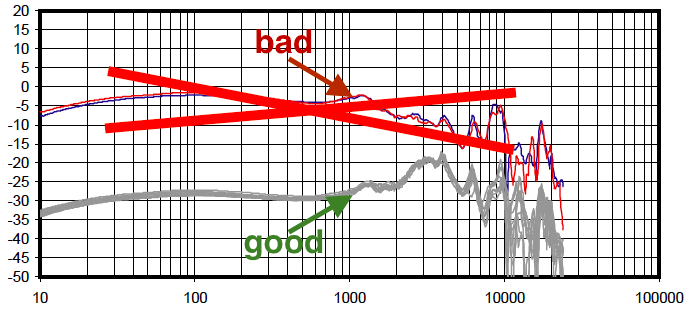I see the charts posted all the time but no clue to where they come from.
A lot of the FR graphs you see come from reviewers and enthusiasts who have their own measurement device called a MiniDSP EARS. Not only are these data technically problematic, but what you see is always a massaged presentation made by combining the actual measurements with some unspecified reference for “neutral” called a compensation curve. Without knowing exactly what flavour of neutral is being used, the results are essentially meaningless.
The most useful graphs are done with extremely expensive equipment and provide the raw data in graphical form:
1. InnerFidelity is the gold standard for that, but sadly the guy has retired so no new headphones are being measured there. But for anything older than a year or so, check here:
(-- Ignore the red and blue line curves. These are adjusted via a non-standard compensation curve. The grey curves are the raw measurements.)
2. A very recent source to come online is Oratory:
https://www.reddit.com/r/oratory1990/wiki/index#wiki_full_list.3A
(-- Here the orange curve is the raw data.)
3. Finally, there is Rtings.com at:
https://www.rtings.com/headphones/reviews
(-- Click on any review, then scroll down until you find the raw graph for that headphone. Click on the little graph for a bigger one.)
You don’t ask how to interpret the graphs, so I assume you’re good to go on that. If you had asked I would have referred you to:
I’ll just add that RTings also lets you compare 2 at the same time. Like so:
https://www.rtings.com/headphones/1-2/graph#329/2031/245
HeadRoom(Headphones.com) worked earlier this month, but it looks like it and its old site is down. It would let you compare up to 4.
https://www.headphones.com/pages/build-a-graph
Diyaudioheaven has a limited number of measured headphones as well:
https://diyaudioheaven.wordpress.com/headphones/measurements
Head-Fi would also provide measurements. But they are buried within each headphone ad post as far as I can tell.
https://www.head-fi.org/threads/head-fi-audio-measurement-lab.885613/
Nope, sadly it’s not. Something bad happened when they (or Tyll) determined what compensation curve to use, and everything came out way warmer than it should have - all InnerFidelity compensated graphs tilt down severely after 1 kHz, as Solderdude shows here (also he lists more sources for graphs in here): 3rd party plots | DIY-Audio-Heaven
My standard is somewhere around the DIYAH / RTings / GoldenEars compensation curves, those measurement sets seem to agree the most with what I’m hearing.
Can 2nd this, rtings and goldenears are the most consistent with what I hear as well, and when using them as a reference for eq, yield better results than innerfidelity.
If you ignore the raw measurements sure, but why would you do that? As I stated in my previous post, when referring to InnerFi ignore the red and blue curves in InnerFi graphs:
Of course, any compensated data for which you know what the compensation looks like and have become comfortable with is great – but limits you to those sources. Learning to read the raw data is what I’m advocating for. Measurement sites with precision, GRAS-type gear and the know-how to use it most often supply the raw data. Still far from perfect but as good as we have available at this time.
Learning to read a raw curve is hardly rocket science. Doesn’t take any more learning curve than reading a particular compensated graph. If I can do it, anybody can do it.
(BTW, does anyone know what compensation curve solderdude uses on DIYAH? I’ve read a lot of pages on that site but can’t find that info.)
I trust Rtings too.
And I trust them even more since I discovered this video:
They’re definitely not just putting headphones on a fake head, clicking “play”, and publishing the data. They’re testing all headphones/earphones with 5-6 people with these “microphones in their ears”, and the result is the averaged/compensated/etc. shown (oh, and you can also see 5 measurements on their website, for the exact same headphone/earphones: click on “consistency”).
Squig.link
